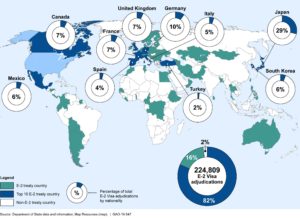Change is a constant in immigration visa adjudications and drastic changes can be implemented from one day to the next without much, if any, notice. For example, the reciprocity fees for the nonimmigrant visas for Australian citizens changed drastically on December 23, 2019.[1] For example, for E-1 and E-2 treaty trader/investor visas, the application fee increased from $105.00 to $3,574.00 (a 3303.81% increase), while L-1 and L-2 intracompany transferee application fees changed from $150.00 to $1,790.00 (a 1604.76% increase). In addition, effective November 12, 2019, the maximum validity of E-1 and E-2 nonimmigrant visas for French citizens was reduced from 60 to 25 months. It is difficult to track the impact of these changes using the Department of State’s visa reciprocity archives, since the information from the prior reciprocity schedule in comparison to the new announced change(s) are not preserved. The lack of prior notice of these changes results in increasing unpredictability regarding the visa process.
What is going on with the Reciprocity Schedule Changes?
These changes are a result in part of the mandate contained in Section 10 of Executive Order 13780 issued back in March of 2017, which requires the Department of State (DOS) to review all nonimmigrant visa reciprocity agreements and arrangements to ensure that they are truly reciprocal. Section 281 of the Immigration and Nationality Act, as amended (INA), requires that visa fees shall be in amounts that correspond to the total of all “…visa, entry, residence, or other similar fees, taxes, and charges assessed or levied against nationals of the United States by the foreign countries of which such nonimmigrants are nationals….” These “reciprocity fees” are reviewed to eliminate the gap between comparable U.S. visa fees and the fees charged by a foreign country to U.S. citizens. Australian fees and charges for their equivalent to the L-1 category for a four year temporary work assignment can exceed USD$10,000.00, so there is a basis for the increase noted above, but the changes were implemented without prior public notice and were applied to visa appointment applications scheduled before the effective date of the change.
Lesson to be learned – Check the reciprocity schedule even on the date of the interview for potential surprises in fees as well as visa validity.
Predictions of Changes in 2020 Regarding E-1 and E-2 Visa Processes
The recommendations contained in a July 2019 report from the U.S. Government Accountability Office (GAO) entitled, “Nonimmigrant Investors: Actions Needed to Improve E-2 Visa Adjudication and Fraud Coordination,” are already being felt at the consular application level with more to be expected in 2020. The report included the following chart regarding E visa use:
Figure 5: E-2 Visa Adjudications by Country of Nationality, Fiscal Years 2014 through 2018

Note: As of June 2019, nationals of 82 countries may be accorded E-2 status. Beginning May 1, 2019, Israeli nationals became eligible to apply for E-2 visas or petition to change to E-2 status. Similarly, New Zealand nationals became eligible to apply for E-2 visas or petition to change to E-2
In addition, the report included the chart below, which reflects some interesting data as to investment trends in fiscal year 2018 for E-2 visas.
Figure 13: Associated Investments Reported by Principal Beneficiaries in Our Generalizable Sample Who Were Approved for E-2 Status in Fiscal Year 2018

Note: This figure is based on self-reported information from principal beneficiaries (e.g., investors, managers, and essential employees) on the qualifying total investment in a U.S. enterprise. The investment may be associated with the beneficiary because the beneficiary may not have made the investment themselves, but the investment was instead made by a separate E-2 investor. The figure does not include investment information reported by dependent E-2 beneficiaries because the Department of Homeland Security does not collect such information, as it is not needed to determine E-2 dependent eligibility. The estimates in this figure are based on the results of our generalizable sample of approved fiscal year 2018 petitions and have a margin of error of +/- 12 percentage points or fewer. Percentages may not sum to 100 due to rounding.
Report Recommendation Topics
Company Registration
For example, one of the recommendations made in the report was for the DOS to develop minimum standards for E-2 company registration programs, including how E-2 registered companies will be re-vetted for qualifications.
In response, DOS reported that it plans to implement a policy of a 5-year mandatory review of companies registered at any post using a company registration program. An E-2 company registration program allows posts to assess companies for E-2 eligibility and after this assessment, the company’s E-2 eligibility is not reviewed each time it seeks an E-2 visa for an employee. As of April of 2019, 7 of the top 10 volume E-2 adjudicating posts had implemented an E-2 company registration program (i.e., London, Madrid, Rome, Tokyo, Osaka, Frankfurt, and Toronto).
- Restricted and Non-Restricted Options – 3 of these posts require all E-2 companies to register, while some posts tie the limited option to volume (e.g., companies with 500 employees in the U.S.). Posts with a requirement for registration typically had from approximately 2,200 to 4,000 companies registered.
- Documentation Required – The documentation required of E-2 visa applicants from registered companies varied widely. At 2 posts, visa applicants were only required to provide a resume and a company support letter regarding their proposed role with the company.
- Revetting Policy – 2 of the 7 posts reviewed company qualification annually while the other 5 only required a follow-up review every 5 years. Consular managers indicated that companies were required to update the post of any changes impacting visa eligibility of the company investors and employees.
Comments by the GAO – The GAO noted that the Bureau of Consular Affairs had not provided minimum standards for E-2 company registration programs.
Changes to Expect – Based on these observations, companies should prepare for more frequent updates to maintain the validity of their E-2 registration programs as well as more detailed documentary requirements for visa and registration applications. Further, companies must track changes to report timely to the consular post(s) maintaining their E-2 registration(s).
E-2 Visa Fraud
The report noted a different perception between DOS and U.S. Citizenship and Immigration Services (USCIS) as to the presence of fraud in E-2 visa applications.
While DOS data from fiscal years 2015 to 2018 noted a decrease in fraud referrals from 664 in 2015 to 280 in 2018, USCIS officials indicated that they consider E-2 visa fraud to be a significant issue.
For DOS, some of the posts had implemented the following actions to address fraud concerns:
- Additional vetting – At one post, all E-2 visa applications are sent to the fraud prevention manager and then to the Assistant Regional Security Officer Investigator (ARSO-1) to conduct additional research for fraud indicators.
- Validation study – One post had conducted a validation study in 2016 as to the extent to which foreign nationals who were issued visas later overstayed or misused their visas. This 2016 study concluded that 25% of the food service E-2 companies had failed within about 3 years and nearly 50% of the E-2 visa holders either failed to depart the U.S. after the company’s demise OR continued to travel to the U.S. using their E-2 visas. This post’s fraud team recommended standardized follow-up procedures for approved E-2 companies to verify ongoing eligibility.
- The September 2019 Monthly Update from the DOS Office of Inspector General (OIG) from the U.S. Embassy in Warsaw noted that the DOS Kentucky Consular Center (KCC) was piloting a program to streamline and improve E-1 and E-2 visa adjudications by using KCC trained experts in its Pre-Adjudication Support Service (PASS) unit to verify the complex documentary requirements for E visas before the submission of cases to consular sections. This pilot program was one of 11 new fraud prevention initiatives implemented by the Director of the KCC during his tenure outlined in the OIG Report number ISP-1-19-36 from August 2019 entitled, “Inspection of Consular Affairs, Kentucky Consular Center.”
USCIS, in contrast, for E-2 initial petitions as well as changes of status and extension petitions for E-2 status uses the following anti-fraud measures:
- Fraud research and site visits – Immigration Service Officers (ISOs) look for anomalies and other indicators of fraud and for any findings send a fraud referral to the service center’s fraud detection office. The fraud detection office then conducts further research such as reviewing company websites and may request a site visit to the company.
- Assessment technology – USCIS uses fraud assessment technology to determine if the company exists and is financially viable. USCIS will typically use the Validation Instrument for Business Enterprise (VIBE). A VIBE review can include such business related information as an office supply store account or utility bills. The KCC does verify business existence using its access to state secretary of state business records.
- Site Visits – ISOs may request site visits to a business site for verification. From fiscal year 2014 to 2018, ISOs made 252 requests based on VIBE results for site visits related to E-2 petitions. For 25% of these site visits (63 requests), USCIS confirmed fraud. Of the 63 confirmed fraud findings, 42 companies were not located at the site stated in the petition and 14 companies had provided fraudulent documents or otherwise misrepresented the facts. DOS consular officers may also request that USCIS conduct site visits. According to USCIS, DOS officers only requested 10 external site visits from fiscal years 2014 to 2018.
Changes to Expect – Based on increased cooperation and data sharing between the DOS and the Fraud Detection and National Security Division (FDNS) of USCIS, companies should conduct regular internal audits to determine if E-2 visa applications or registrations require updates or amendments. In addition, companies should expect and prepare for on site verification visits as to their E-2 registrations and visa applications for employees.
About the Author:
Kathleen Campbell Walker is a member of Dickinson Wright PLLC and serves as a co-chair of the Immigration Practice Group. She is a former national president and general counsel of the American Immigration Lawyers Association (AILA) and is Board Certified in Immigration and Nationality Law by the Texas Board of Legal Specialization. She serves on the AILA Board of Governors. In 2014, she received the AILA Founder’s Award, which is awarded from time to time to the person or entity, who has had the most substantial impact on the field of immigration law or policy in the preceding period (established 1950). She has testified several times before Congress on matters of immigration policy and border security. She may be reached in our El Paso, TX office at 915-541-9360 and you may view Kathleen’s bio here.

[1] These reciprocity fees for issued visas are different form the base visa application fees for machine readable visas (MRV).
